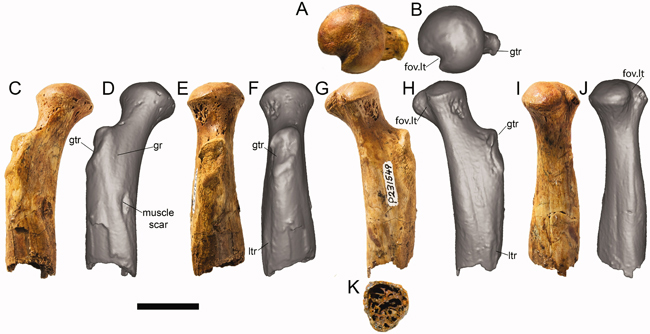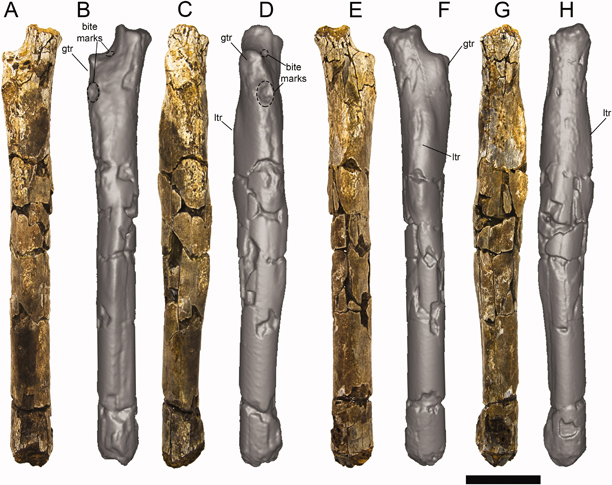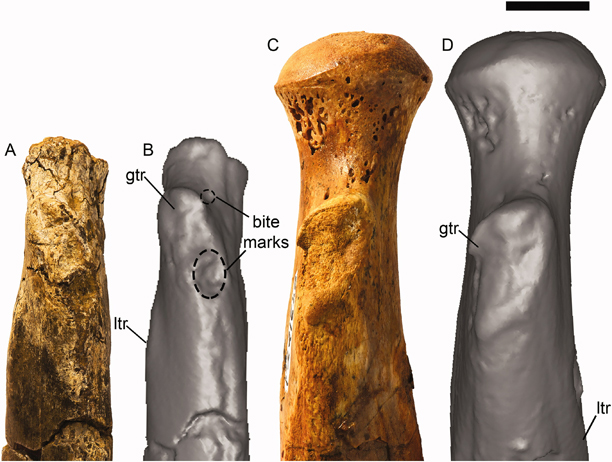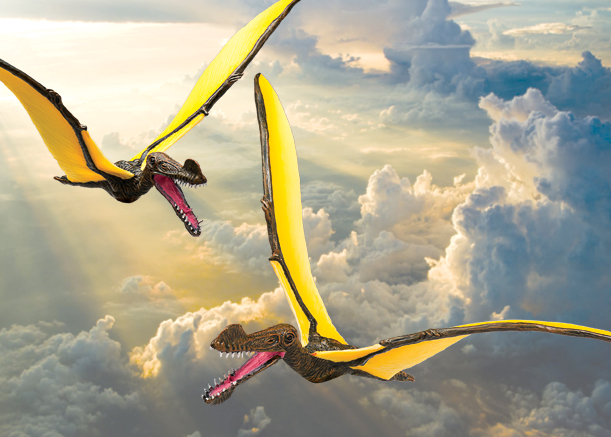Scientists have identified two partial pterosaur thigh bones that despite one being at least ten million years older than the other, have been identified as belonging to the same type of flying reptile (Anhangueria). Furthermore, one of the bones preserves a potential bite mark tentatively attributed to a crocodilian.

Anhangueria indet. partial right femur from the Toolebuc Formation (NMV P231549): A, B, proximal; C, D, posterior; E, F, dorsal; G, H, anterior; I, J, ventral and K, distal views. A, C, E, G, I and K are photographs; B, D, F, H and J are 3D renders derived from surface scan data. Scale bar = 2 cm. Picture credit: Pentland et al.
Picture credit: Pentland et al
Two Rare Australian Pterosaur Fossils
The researchers who include famous Australian vertebrate palaeontologists Patricia Vickers-Rich and Thomas Rich report that the two bones although found over 200 miles apart, both come from pterosaurs from the same pterosaur clade (Anhangueria).
Specimen number NMV P231549 was collected in 1991 at Slashers Creek Station, southeast of the small town of Boulia (Queensland), from Toolebuc Formation deposits (middle to upper Albian) and is believed to be at least 100 million years old.
Specimen number AODF 2297 was found in 2004 at Belmont Station, around 35 miles northeast of the town of Winton in Queensland. It came from deposits associated with the “upper” Winton Formation (Cenomanian-lowermost Turonian stage of the Late Cretaceous). It is estimated to be around 10 million years younger.

Anhangueria indet. partial left femur from the Winton Formation (AODF 2297): A, B, posterior; C, D, dorsal; E, F, anterior; and G, H, ventral views. A, C, E and G are photographs; B, D, F and H are 3D renders derived from surface scan data. Scale bar = 2 cm. Picture credit: Pentland et al.
Picture credit: Pentland et al
Although pterosaur fossils are exceptionally rare in Australia and most specimens are extremely fragmentary, their three-dimensional preservation has enabled palaeontologists to learn a great deal about the type of pterosaurs that ranged over this part of Gondwana during the Cretaceous.
Lead author of the scientific paper describing these pterosaur bones, Adele Pentland (PhD student at Swinburne University, Melbourne, Victoria), was also the lead author of another scientific paper published in 2019 which described another anhanguerid pterosaur Ferrodraco lentoni.
To read more about F. lentoni: The Most Complete Pterosaur Specimen Found in Australia to Date.
The picture (above) shows two Tropeognathus pterosaurs, soaring high in the sky. These pterosaurs are typical of the Anhangueridae. The models are from the Mojo Fun series.
To view the range of Mojo Fun figures available from Everything Dinosaur: Mojo Fun Prehistoric Animal Figures.
The Winton Formation fossil preserves a potential bite mark, that the researchers have tentatively proposed was made by a crocodylomorph. It is not known whether this feeding trace represents predation or post-mortem scavenging.

Comparisons between greater trochanters of the Toolebuc Formation (NMV P231549) and Winton Formation (AODF 2297) pterosaur femora. AODF 2297 in A, B, dorsal view. NMV P231549 in C, D, dorsal view. A and C are photographs; B and D are 3D renders derived from surface scan data. Picture credit: Pentland et al.
Picture credit: Pentland et al
The scientists conclude that these new pterosaur fossils are a valuable addition to the meagre list of pterosaur specimens found in Australia and attest to the cosmopolitan distribution of anhanguerians during the Early and early Late Cretaceous.
The scientific paper: “New anhanguerian pterosaur remains from the Lower Cretaceous of Queensland, Australia” by Adele H. Pentland, Stephen F. Poropat, Matt A. White, Samantha L. Rigby, Patricia Vickers-Rich, Thomas H. Rich and David A. Elliott published in Alcheringa: An Australian Journal of Palaeontology.







Leave A Comment